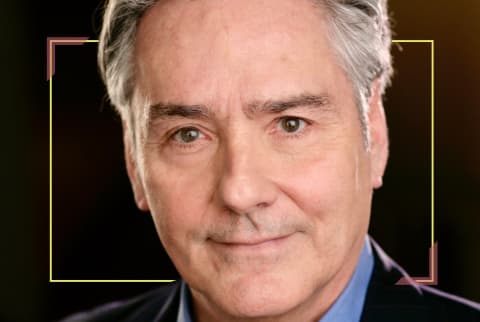I Had Debilitating Phobias For 50+ Years — Until I Found This Treatment
At the age of 61, I found a therapy that worked for me.

Image by mindbodygreen / Michael baldwin March 4, 2023 While some health issues are visible to the outside world, many people face chronic conditions that don't have externally visible signs or symptoms—also known as invisible illnesses. In mindbodygreen's series, we're giving individuals with invisible illnesses a platform to share their personal experiences. Our hope is their stories will shed light on these conditions and offer solidarity to others facing similar situations.
Advertisement
This ad is displayed using third party content and we do not control its accessibility features.
I sat at my desk in my 6th-grade classroom, my anxiety mounting. I counted down the minutes until the big hand on the clock above the chalkboard finally reached 12:00 noon. As my classmates emptied out of the room, headed to the cafeteria for lunch, my palms got cold and clammy, and I felt a growing sense of panic. I had to use the bathroom, but the prospect of entering a stall in the school’s boys’ room filled me with so much fear that doing so would be unthinkable. I would have to run home—and make it back before anyone noticed I was missing. Fortunately, our house was only eight blocks from school. Unfortunately, this extreme terror of using public restrooms followed me into adulthood. It was just one of the psychological challenges I coped with growing up, starting when I was about six or seven. I suffered from multiple phobias, although I had no idea what a phobia was as a child and young adult. I thought being terrified of using a public restroom, having an acute fear of heights, and experiencing a full-blown panic attack at even the suggestion of intimacy with a woman was simply the way I was wired. After seeking therapy, I found some solace—and a diagnosis.
My phobias only became more entrenched as I moved into adulthood, and they were in charge. As limiting and immobilizing as they were, I continued to think of them as quirks or flaws that I just had to negotiate my life around.
I began psychotherapy in my 20s, and my search for emotional healing stretched over 22 years, and seven different therapists. I was exposed to traditional talk therapy, CBT therapy, and Intensive Short-Term Dynamic Psychotherapy, but none of them offered any substantive or lasting relief.
My search ended at the age of 61, when I walked into the office of an EMDR therapist. While my other therapists had focused on my various phobias, this one zoomed out to look at the bigger picture of my life. To my surprise, he diagnosed the source of my phobias: early childhood trauma.
I was introduced to Eye Movement Desensitization and Reprocessing (EMDR), an evidence-based, memory-focused trauma therapy. And from the very first EMDR session, I felt relief. My therapist would guide me to a memory, or physical sensation, or emotion from a particular time in my childhood and have me move my eyes back and forth, from side to side, following his two fingers. This “bilateral stimulation,” a unique feature of EMDR therapy, allowed my brain to process memories that got frozen in my nervous system long ago and this, in turn, led to a dramatic decrease in my symptoms. My past was no longer intruding into my present.
Advertisement
This ad is displayed using third party content and we do not control its accessibility features.
Through my treatment, I learned that trauma is a part of life, but that it needn’t be a source of shame.
EMDR was life-changing for me. In time, I came to understand that I had suffered significant childhood trauma. The memories I processed in therapy included extreme, willful neglect, along with abuse at the hands of my parents, my brother, a school bully, and a pediatrician. These memories had been so fragmented in my conscious adult mind, that I could never make sense of them. Yet, they haunted me, and distorted how I viewed myself, the world, and the choices I made. Through my treatment, I learned that trauma is a part of life, but that it needn’t be a source of shame.
What I want people to understand about living with trauma.
Unresolved trauma causes pain and suffering until it is processed and defused of its emotional charge—like a thorn in your side or stone in your shoe. Traumatic memories that remain frozen in the nervous system can wreak untold havoc. Many studies have been conducted over the years that have shown EMDR to be highly effective in resolving PTSD1 and other stress-related, life-limiting disorders2, including chronic pain, depression, anxiety, phobias, and addictions. Like me, many who seek out EMDR therapy are unhappy in their lives and experience troubling symptoms, but aren’t necessarily aware they have a history of trauma.
Advertisement
This ad is displayed using third party content and we do not control its accessibility features.
After my recovery journey, life is more manageable.
I have traded in my old “operating system,” plagued with anxiety, doubt, fear, and a core belief that I was worthless and unlovable, for a new one. I now wake up in the morning untethered and at peace. My phobias and nightmares have disappeared. Once an over-achieving workaholic, obsessed with status and achievement, I have become my authentic self; I no longer need the façade I created through the years to mask my internal turmoil.
There are certified EMDR therapists worldwide, and if you’re experiencing challenges, I strongly believe doing this type of work can be transformational.
Unresolved trauma can have a profound effect on our mental health, but recovery is possible—and it doesn’t have to take a lifetime.
Advertisement
This ad is displayed using third party content and we do not control its accessibility features.

 Tfoso
Tfoso 






























.jpeg?trim=0,89,0,88&width=1200&height=800&crop=1200:800)


